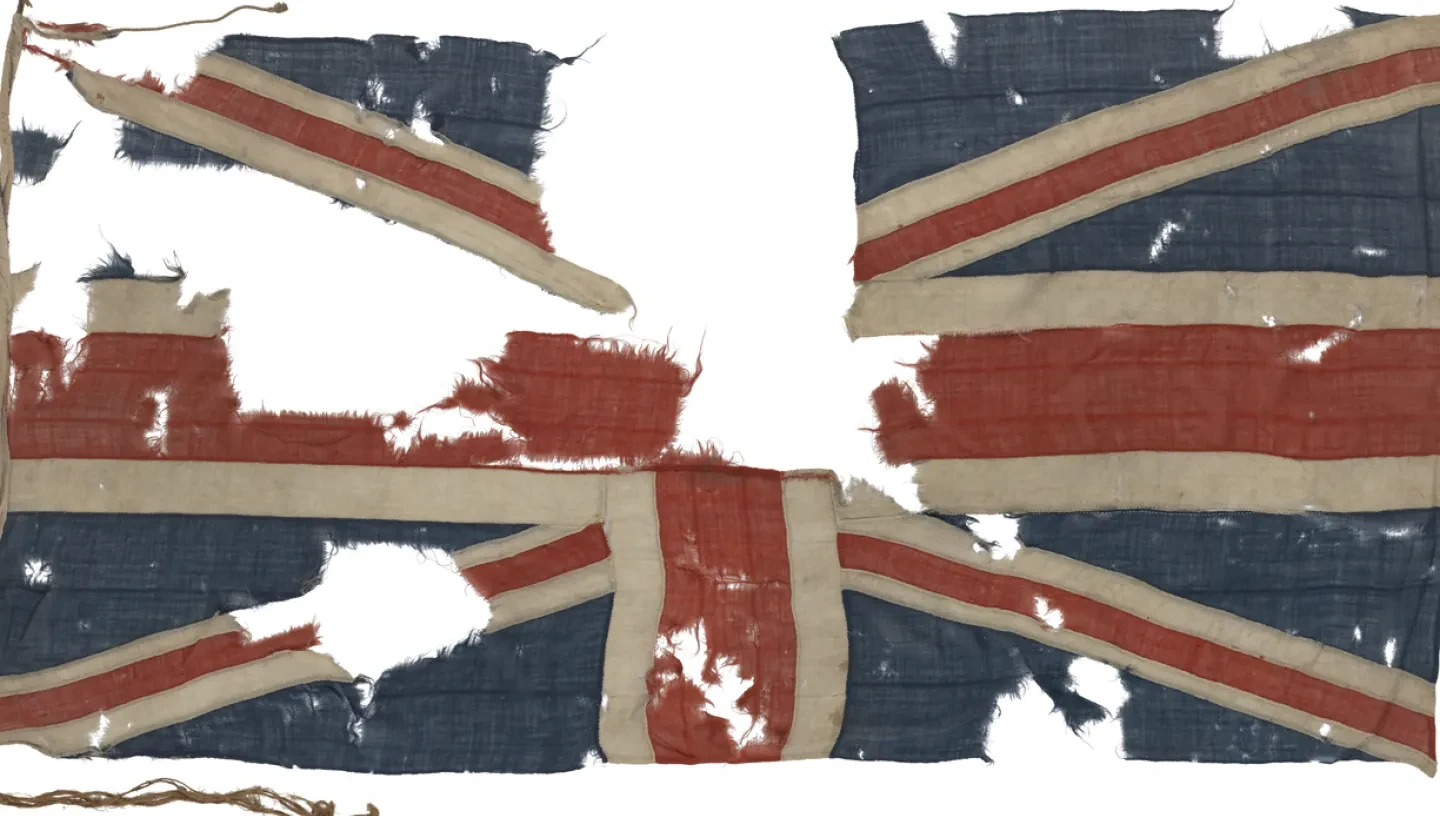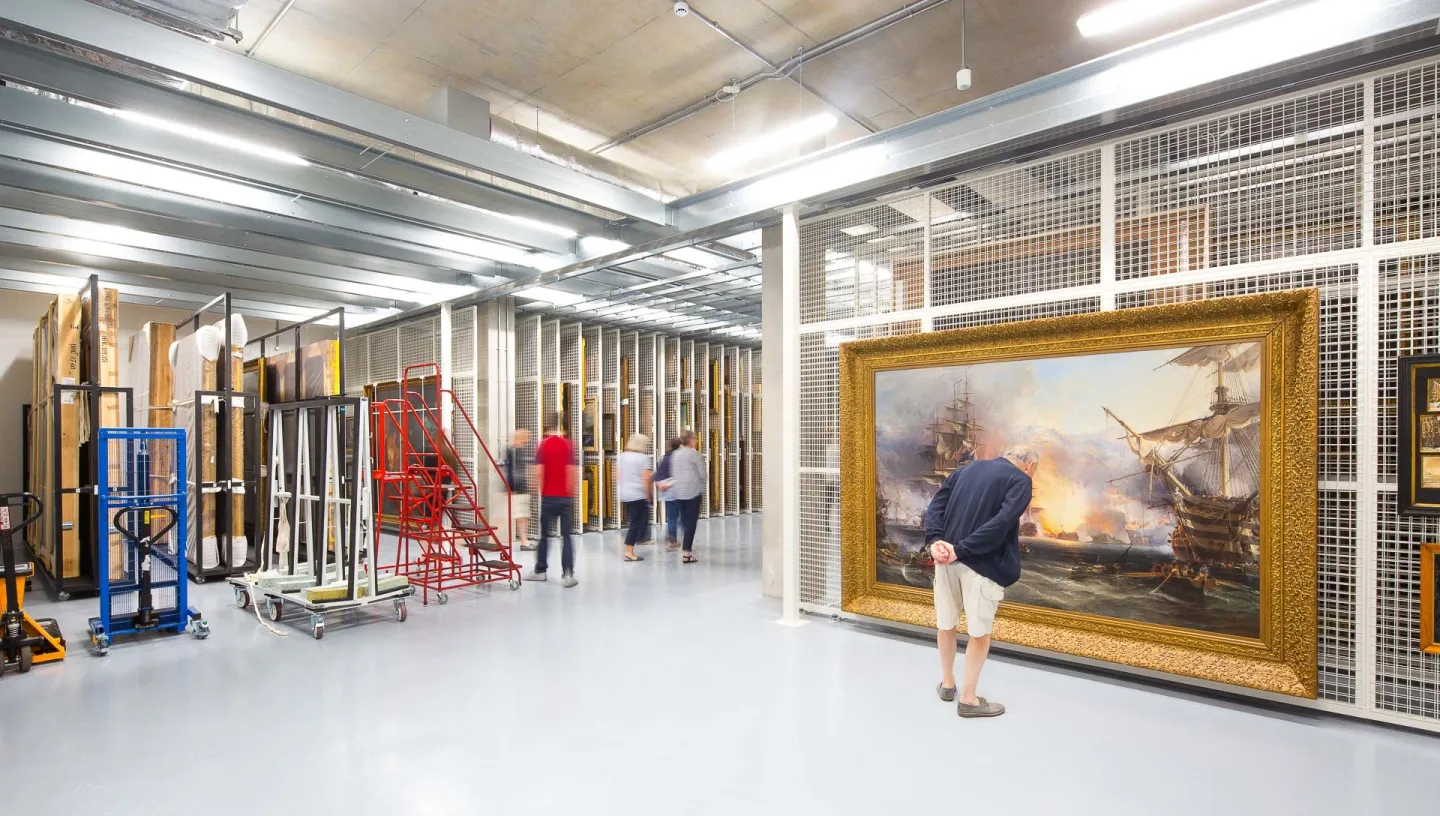
The National Maritime Museum's flag collection contains more than 1000 items, with most flags dating from the 18th century and includes Union Jacks, standards and banners and flags from war and conflict.
A selection of our flags are on display in the National Maritime Museum, and you can explore much more of the collection online.
Understanding flag design
There are many types and styles of flag design:
- Pennants are long, triangular or swallow-tailed tapering flags, especially flown at the masthead of a vessel in commission.
- An ensign is a national flag displayed on ships and aircraft, often with the special insignia of a branch or unit of the armed forces. Such as a badge, emblem, or token of power or authority.
- A saltire is a cross made by two diagonal lines, often connecting the corners of a flag.
- Burgee flags are small, often triangular and frequently the distinguishing flag of a yacht club. Flown from the masthead, many are used to identify boats whose owners belong to a particular club.
- House flags were first introduced in the late 18th century. They were used to indicate the company a ship belonged to, and enabled shipowners to identify their cargo and passengers as their ship approached the port.
- Signal flags represent the most important form of communication at sea. In 1805 Admiral Nelson signalled one of his most famous lines as the Battle of Trafalgar was about to commence - 'England expects that every man will do his duty'.
- The purpose of command flags was to indicate 'flagships', meaning ships with commanders on board.
- Sledge flags. These silk flags were used by British naval polar expeditions from the mid-19th century until the 1930s.
Notable flags in our collection
Many of the oldest and more interesting flags are military trophies captured from French and Spanish forces during the wars of the 18th and early 19th century. Others were acquired due to their association with famous people or battles.
Famous flags
-
The flag of John Willis and Son flown by Cutty Sark.
-
Captain Robert Falcon Scott's sledge flag from his expedition to the South Pole in 1912, plus sledge flags from other polar expeditions including the Franklin search expeditions (1845), Sir George Nares' polar expedition (1875), and the Borchgrevink Antarctic expedition (1898).
-
Ensign of the Spanish vessel San Ildefonso captured at the Battle of Trafalgar (1805).
-
A rare White Ensign (c. 1794) from HMS >Brunswick associated with Captain John Harvey who died of wounds received in the battle of the Glorious First of June, plus the Union flag used as a command flag by Lord Howe on the Queen Charlotte.
-
A silk broad pennant carried by Sir Harry Keppel during the Second China War action at Fatshan Creek in 1857. One of only two command flags in the collections which precede the changes of 1864.
-
Three Union flags dated before 1801, without the red saltire of St Patrick.
The Union Jack
Most of the British naval flags in our collection are from the 19th and 20th century. The design of the Union flag was last changed in 1801 when the St Patrick saltire (a red diagonal cross) was added to represent the union with Ireland.
Historically, Union flags were flown from a jackstaff on the bowsprit of naval vessels, until changes in rigging around 1720 made this impractical. Since then, the Jack, or Union Jack, has only been flown by warships when in harbour.
At the Battle of Trafalgar, in accordance with Nelson's order of 10 October 1805, the Union was used by the British fleet as a battle flag; and likewise, although intermittently, during the First World War.
Standards and banners
Our collection includes sea-going Royal Standards dating from the late 18th century onwards, most notably the silk standard of Frederick Augustus, Duke of York and Albany, second son of George III.
Heraldic flags with naval associations include the Order of the Bath banners of Admiral John Thomas Duckworth (1748-1817), Sir Alexander Cochrane (1758-1832) and Sir John Colpoys (1742-1821). They originally hung in the chapel of the order at Westminster Abbey.
War and conflict
The flags we hold include two notable groups of flags from the battle of the Glorious First of June (1794) and the Battle of Jutland (1916).
We also have a group of Chinese flags dating from the Opium Wars to the 1920s, plus flags from the the First and Second World Wars: examples from the allies and opponents include German and Japanese ensigns.
We have one example of the modern pattern Union flag damaged by Russian shot during the Crimean War.
The Pope and Bolt collections
Assembled between 1917 and 1967 the Pope Collection includes 273 house flags representing the distinguished history of flag design in the British shipping industry. Nearly 25 are divided into quarters and around 20 bear a saltire cross. Many of the flags are made of modern, synthetic fibres.
The Bolt Collection comprises the flags of shipping lines collected around 1911. Many of the flags in this group are made of traditional wool bunting and sewn by machine.
Government department flags
We hold an interesting collection of Post Office blue ensigns include the pattern with a badge showing a galloping postboy (1833-1864), and a later pattern depicting Father Time with his hour glass shattered by a lightning bolt (1884).
Ensigns of other government departments include those of the Royal Naval Mine Watching Service, The Board of Trade and the Naval Supply and Transport Service
Yacht club burgees
Highlights include George V owner's flag from his racing cutter Britannia and the ensign and burgee of the Royal Harwich Yacht Club. This flag was flown by F. L. McClintock's vessel Fox on her successful mission to discover the fate of Sir John Franklin's Arctic expedition in 1857-59.
Using our collections for research
The collections at Royal Museums Greenwich offer a world-class resource for researching maritime history, astronomy and time. Find out how you can use our collections for purposes of research.
Find out how you can use our collections for research
